
The Metropolitan line, colloquially known as the Met, is a London Underground line between Aldgate in the City of London and Amersham and Chesham in Buckinghamshire, with branches to Watford in Hertfordshire and Uxbridge in Hillingdon. Printed in magenta on the tube map, the line is 41.4 miles (66.7 km) in length and serves 34 stations. Between Aldgate and Finchley Road, the track is mostly in shallow "cut and cover" tunnels, apart from short sections at Barbican and Farringdon stations. The rest of the line is above ground, with a loading gauge of a similar size to those on main lines. Just under 94 million passenger journeys were made on the line in 2019.

Neasden is a suburban area in northwest London, England. It is located around the centre of the London Borough of Brent and is within the NW2 (Cricklewood) and NW10 (Willesden) postal districts. Neasden is near Wembley Stadium, the Welsh Harp, and Gladstone Park; the reservoir and River Brent marks its boundaries with Kingsbury and Wembley, while Gladstone Park and the Dudding Hill line separates it from Dollis Hill and Church End respectively. The A406 North Circular Road runs through the middle of Neasden; to the west is the Neasden Underground Depot, Brent Park retail area and the St Raphael's Estate; on the east is Neasden tube station, the large Neasden Temple, and former Neasden Power Station. The area is known as the place where Bob Marley lived after moving from Jamaica, living at a house in The Circle; the house was honoured with a blue plaque in 2012.
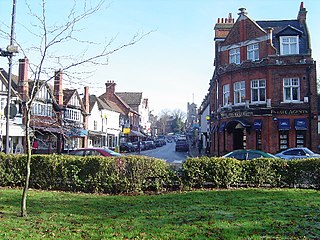
Pinner is a suburb in the London Borough of Harrow, northwest London, England, 12 miles (19 km) northwest of Charing Cross, close to the border with Hillingdon, historically in the county of Middlesex. The population was 38,698 in 2021.

Sir John Betjeman, was an English poet, writer, and broadcaster. He was Poet Laureate from 1972 until his death. He was a founding member of The Victorian Society and a passionate defender of Victorian architecture, helping to save St Pancras railway station from demolition. He began his career as a journalist and ended it as one of the most popular British Poets Laureate and a much-loved figure on British television.

Baker Street is a London Underground station at the junction of Baker Street and the Marylebone Road in the City of Westminster. It is one of the original stations of the Metropolitan Railway (MR), the world's first underground railway, opened on 10 January 1863.

Wembley Park is a London Underground station in Wembley Park, north west London. The station is served by the Jubilee and Metropolitan lines and is in Travelcard Zone 4. It is located on Bridge Road (A4089) and is the nearest Underground station to the Wembley Stadium and Wembley Arena complex. This is where the Jubilee line from Stanmore diverges from the Metropolitan line, which was formerly a branch of the Metropolitan Railway and was taken over by the Bakerloo line and today part of the Jubilee line.
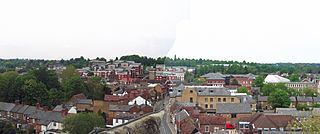
Rickmansworth, a town in south-west Hertfordshire, England, is located approximatly 17 miles (27 km) north-west of central London, 5 miles (8 km) south-west of Watford and inside the perimeter of the M25 motorway. The town is mainly to the north of the Grand Union Canal and the River Colne.

Kingswood is a hamlet of 30 dwellings on the South side of the A41 from Waddesdon to Bicester and between the villages of Ludgershall and Grendon Underwood in Buckinghamshire, England. Kingswood is also a civil parish within Aylesbury Vale district. Parish matters are currently administered via a parish meeting. There is one Italian restaurant and public house, Canaletto which opened in 2013. There is also a derelict Village Hall blown down in the Great Storm of 1987.

The Metropolitan Railway was a passenger and goods railway that served London from 1863 to 1933, its main line heading north-west from the capital's financial heart in the City to what were to become the Middlesex suburbs. Its first line connected the main-line railway termini at Paddington, Euston, and King's Cross to the City. The first section was built beneath the New Road using cut-and-cover between Paddington and King's Cross and in tunnel and cuttings beside Farringdon Road from King's Cross to near Smithfield, near the City. It opened to the public on 10 January 1863 with gas-lit wooden carriages hauled by steam locomotives, the world's first passenger-carrying designated underground railway.
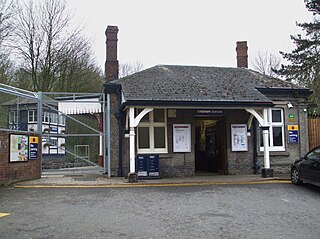
Chesham tube station is a London Underground station in Chesham, Buckinghamshire, United Kingdom. It was opened on 8 July 1889 by the Metropolitan Railway (MR). It is the terminus station of the Chesham branch of the Metropolitan line, which runs from Chalfont & Latimer. The station, a Grade II listed building, is in London fare Zone 9.

Three Rivers is a local government district in south-west Hertfordshire, England. Its council is based in Rickmansworth. The district borders Hertsmere, Watford, St Albans, Dacorum, Buckinghamshire, and the London boroughs of Hillingdon and Harrow.
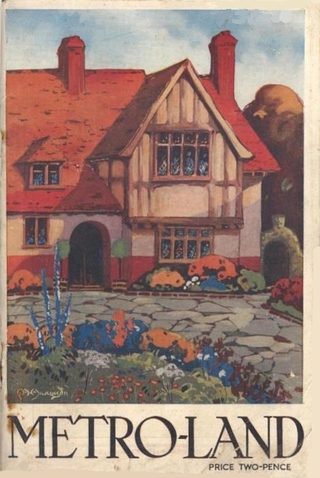
Metro-land is a name given to the suburban areas that were built to the north-west of London in the counties of Buckinghamshire, Hertfordshire and Middlesex in the early part of the 20th century that were served by the Metropolitan Railway. The railway company was in the privileged position of being allowed to retain surplus land; from 1919 this was developed for housing by the nominally independent Metropolitan Railway Country Estates Limited (MRCE). The term "Metro-land" was coined by the Met's marketing department in 1915 when the Guide to the Extension Line became the Metro-land guide. It promoted a dream of a modern home in beautiful countryside with a fast railway service to central London until the Met was absorbed into the London Passenger Transport Board in 1933.
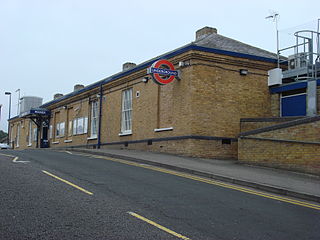
Pinner is a London Underground station. The station was opened in 1885 as part of the Victorian expansion of dormitory suburbs, and was one of the stations included in the Metro-land project in the early 20th century. The site is served by several bus routes including links to the Hatch End railway station which was known as Pinner & Hatch End prior to 1920. Step free facilities were opened in 2008. The station is on the Metropolitan line between Northwood Hills and North Harrow stations, and is in Travelcard Zone 5.

Rickmansworth is an interchange railway station in Rickmansworth, Hertfordshire, northwest of central London, served by the London Underground Metropolitan line and by Chiltern Railways. It is one of the few London Underground stations beyond Greater London and as a consequence is in Travelcard Zone 7. The station is a good location to alight from to explore the Chess Valley.

Northwood is a station on the Watford branch of the Metropolitan line, in Travelcard Zone 6. The station is located just off the main road through the town, Green Lane. The line serves as the sole continuous link between the town of Northwood and London, key for a region known as Metro-Land.

South West Hertfordshire is a constituency in the House of Commons of the UK Parliament, represented since 2019 by Gagan Mohindra, a Conservative.

The London–Aylesbury line is a railway line between London Marylebone and Aylesbury, going via the Chiltern Hills; passenger trains are operated by Chiltern Railways. Nearly half of the line is owned by London Underground, approximately 16 miles (26 km) – the total length of the passenger line is about 39 miles (63 km) with a freight continuation.
Edward Mirzoeff CVO, CBE is a prominent British television producer and documentary filmmaker.

The Croxley Rail Link, or the Metropolitan Line Extension, is a proposed railway engineering project in the Watford and Three Rivers districts of Hertfordshire, England, that would have connected the London Overground and the London Underground's Metropolitan line at Watford Junction. If the link were to go ahead, the Metropolitan line's terminus at Watford Underground station would be closed and the line diverted and extended from Croxley to Watford Junction via a reopened section of closed line. The main proponent of the scheme was Hertfordshire County Council but it failed to win the support of Transport for London (TfL) which owns the Watford branch. The engineering works would have consisted of the realignment of the disused Watford and Rickmansworth Railway's line between Croxley Green and Watford High Street, with the construction of a viaduct over the Grand Union Canal, River Gade and A412 road and two new stations before branching into the London Overground line near Watford High Street and continuing to Watford Junction.

A Passion for Churches is a 1974 BBC television documentary written and presented by the then Poet Laureate Sir John Betjeman and produced and directed by Edward Mirzoeff. Commissioned as a follow-up to the critically acclaimed 1973 documentary Metro-land, the film offers Betjeman's personal poetic record of the various rituals taking place throughout the Anglican Diocese of Norwich and its churches in the run-up to Easter Sunday using the framing device of the Holy sacraments.





















